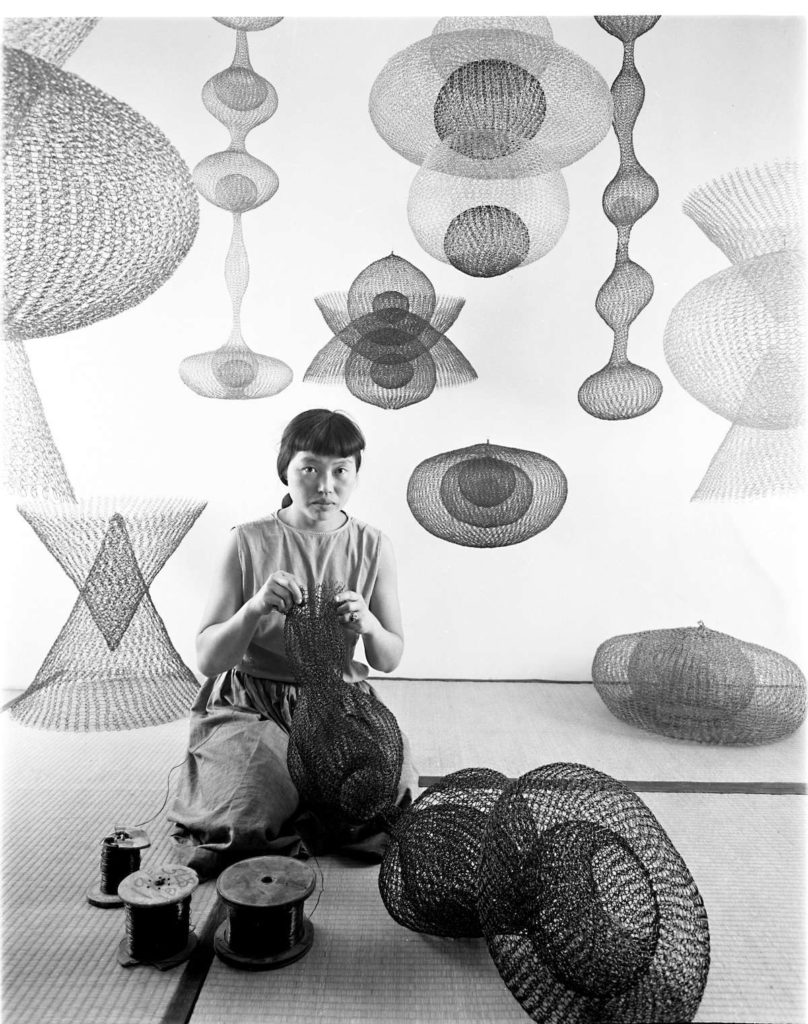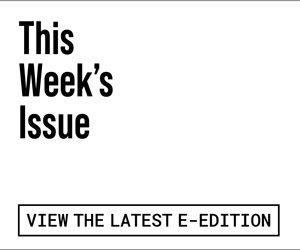In a fourth floor gallery at the San Francisco Museum of Modern Art, two women stand transfixed. Gazing upward at a hanging sculpture made with galvanized steel wire and lit by a diffuse spotlight that casts a shadow resembling either a scorpion or an elephant’s head, their inscrutable facial expressions burst into astonishment and delight.
Leaning into each other as if they’re conspiratorially discussing a secret, their voices convey wonder and—a sentiment currently in rare supply—respect minus intimidation and without discomfort.
The artwork inspiring the heady cocktail of emotions and whispered words is one of many bearing the title, “Untitled,” in SFMOMA’s extraordinary exhibition, “Ruth Asawa: Retrospective.” In 12 gallery spaces and more than 300 works, the inarguable creativity and legacy of the late renowned Bay Area artist is revealed. Born in Norwalk, California in 1926, Asawa came to the Bay Area in 1949 and died in San Francisco in 2013.
This is SFMOMA’s first posthumous retrospective of her work. (An all-women group exhibit, “Four Artist-Craftsmen,” in 1954, and a mid-career survey in 1973 preceded the retrospective.)
Featuring her well-known looped-wire sculptures, the exhibit illuminates the full breadth of Asawa’s vision and multifaceted practices. Included are the addition of tied-wire pieces, clay and bronze casts, masks, paperfolds, paintings, drawings, sketchbooks, prints, supersize public art photographs, videos, archival materials, an oral history booth, a garden terrace based on Asawa’s home garden, a semi-recreation of the living room in the Noe Valley in which she lived and established her studio in 1960 and more.
Asawa was raised on the family’s farm. Her seminal life experiences and artistic influences include her family being forced to relocate to Japanese internment camps in California and Arkansas when she was in high school, pursuing art as a student at North Carolina’s Black Mountain College from 1946-49 and learning looped-wire basketry in Toluca, Mexico. In 1947, she married a fellow BMC student, architect Albert Lanier, and moved to the Bay Area, where the couple raised their six children—two adopted, four biological.
With the breathtaking copious artwork she created, Asawa gained greater visibility through collaborative public art works such as “Andrea” (1966-68) at Ghirardelli Square and the “Garden of Remembrance” (2000-02) at San Francisco State University. Endlessly inventive and devoted to public art education for children, Asawa co-founded the Alvarado School Arts Workshop in 1968 and was instrumental in founding San Francisco’s first public arts high school in 1982.
In an interview, Janet Bishop, Thomas Weisel Family chief curator, says, “All of her life experiences inform who she became as an artist, but I think that drive and boundless creativity were absolutely inside her. She never repeated herself. In hundreds of wire sculptures, every single one is unique. I’m fascinated by the relationships between those wire sculptures and her other works. She uses transparency, forms within forms, manifested across multiple mediums. That will be revelatory to people viewing the exhibition.”
Indeed, from the first gallery’s “Untitled” oil on paper painting with abstract orbit-shaped figures dancing across a brilliant yellow background that foreshadows her sculptures, Bishop’s point is proven. In a small, adjacent vestibule, Asawa’s iterative genius is further demonstrated with “Untitled” (Study in Greek Meander), an ink on paper work rendered with row upon row of a simple motif.
Another untitled work has Asawa enlisting Black Mountain College’s laundry stamp on fabric, creating a “BMC” pattern later produced and purchased by a commercial wallpaper and textile design company, for which she was never credited.
About the sculptures and in other examples, Bishop says, “If you look at her paintings, the two-dimensional drawings she did in the 1950s of chairs, and the wire sculptures, you see consistent interests coursing through them. She was always open to new materials and processes. She found a medium that could capture the gnarled nature of the sycamore trees in Golden Gate Park. She drew and then splattered them with paint, and they’re magical.”
That Asawa was brilliant at exploring form and pattern in multiple mediums is demonstrated not only by the exhibit’s wire sculptures that range from voluptuously human to spiky to shapes reminiscent of connected droplets of sap falling from trees, but origami works made with paper. A large scale monochrome wall-mounted paperfold employs a single piece of paper and yields a bold, dynamic, black-and-white form resembling a leaf or elongated pine cone. The design was subsequently patented after being adapted to modular plastic panels.
“She was so good at figuring things out. Specifically, it’s mesmerizing to stare at the sculptures and try to figure out how she did it,” Bishop says.

Beyond opportunities for staring and puzzling—and being struck by Asawa’s brilliant execution and indefatigable explorations of positive and negative spaces within forms—the exhibit establishes the seamlessness of Asawa the artist and Asawa the woman, spouse, mother, gardener, educator, collaborator and public activist. In every role, innovation prevails.
Already steeped in the organic world of flowers, trees and plants, she received a desert plant from a friend. Asawa began drawing it, then moved to sculpting curly forms using spools of wire, later adding bundles of wire with straighter qualities. The exhibit’s freestanding, hanging and wall-mounted examples provide some of the most playful, quirky works in which fun merges organically with serious, gifted craft.
In a photo showing Asawa leading a Baker’s Clay workshop, a group of children and other collaborators cluster behind and beside her. The “dough” was made of simple kitchen supplies—water, flour.
“The seamlessness between work and home life; it was important for her kids to know what she did, and cultivate their own tactile practices,” says Bishop. “Bread dough figurines made with her kids and others informed serious application for her bronze sculptures. A kid who once made wire sculptures with her has helped us recreate one of her sculptures. In these ways, her gifts have passed from one generation to the next.”
A gallery not literally replicating but evoking her Noe Valley home and rooms devoted to public works (photos and elements of previously mentioned Andrea and the Japanese American Internment Memorial) are definite highlights. Within the concept of things monumental, there are the actual, nine-foot tall carved redwood doors that marked an auspicious entry to her home.
“The Doors,” curvaceously carved and ingeniously incorporating a nearly hidden door “handle,” offer complementary serpentine wood grain and reddish/brown tones that exude warmth. Equally welcoming is the casual atmosphere of the living room setting that incorporates a room-size rug and various chairs for lounging arranged underneath floating wire sculptures suspended from an extremely high ceiling.
Bishop says the SFMOMA team intentionally strived to present the fullest possible arc of Asawa’s work.
“We chose the living room, because despite excavating the home to create a workshop studio, she preferred working upstairs, in the thick of family life,” Bishop explains.
“Moving to the public work, it’s fascinating; you wouldn’t necessarily recognize them as being the same artist from one to the next,” Bishop continues. “She painted, drew and was so creative and collaborative. She took her art practices from bread dough to bronze. She began working with wire because it was easy to start and stop. Working upstairs in the living room, close to a pot of soup in the nearby kitchen, she could be responsive to the needs of her family.
“She was one of a kind,” says Bishop. “The best of the best artists of our time.”
Ruth Asawa: Retrospective, SFMOMA, now through Sept. 2, 10am-5pm Mon-Tue, Fri-Sun; noon-8pm Thu; closed Wed; 151 Third St., San Francisco. Info: sfmoma.org.






